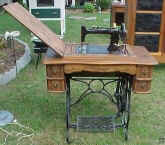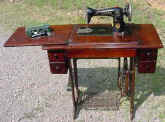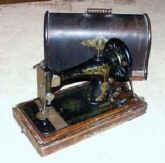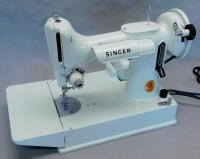A good rule of thumb for determining
the desirability of an early sewing machine (pre-1870) is its serial
number.
A sewing machine by any maker with a serial number of 500 or less would
be considered early, desirable and pretty rare. Low serial numbers by more obscure makers would
be even better. At the left is an
 example of a sewing machine
called the Ne Plus with serial # 21. It dates from the mid 1850's. Note how different it
looks from later sewing machines. To see many other examples of early
sewing machines go to my
Past Sales Archives
on our sister website
www.AntiqBuyer.com. Those are the type and style
sewing machines we seek and will buy.
example of a sewing machine
called the Ne Plus with serial # 21. It dates from the mid 1850's. Note how different it
looks from later sewing machines. To see many other examples of early
sewing machines go to my
Past Sales Archives
on our sister website
www.AntiqBuyer.com. Those are the type and style
sewing machines we seek and will buy.
To see more common machines keep reading.
The
simple fact that your sewing machine is old / antique does not necessarily mean it is
desirable or valuable.
Any sewing machine
with a serial # above 50,000 would be considered "Late" and
relatively common. In other words, your Wheeler & Wilson #9,
White, Singer, Domestic, Wilcox & Gibbs, etc. "antique" sewing machine, or any other
sewing machine with a serial number in
the 6 or 7 digit range, is considered late and relatively common. The machine
may date from 1880, and does have some value, but it would almost always
be as a decorator item and not as a collectible with a steady
 demand
and known value
from sewing machine collectors.
demand
and known value
from sewing machine collectors.
In other words, and
bottom line, common
/ later sewing machines are worth
whatever you can sell them for. Or whatever you can get a
willing buyer to pay.
That might be $1000 or
more, but more likely $50 or less. It boils down to how
good a salesperson are you, how much time and energy your willing to
spend, what or who your customer base is, and
the sales venue you choose.
To the right and just below are pictures of typical
looking treadle sewing
machines. Sewing machines like this typically date
from the late 1870's and up until the 1930's or later. Names such as the Standard, Jones, White,
Eldredge,
Domestic, New Home, Princess, Franklin, Household, Free, Westinghouse,
Remington, Greybar, Minnesota, later Singer Models, and many
others are examples of later machines that are generally not in
great demand, and thus not very desirable
or valuable.
These later sewing machines can come with a host of different
names, and in general were made by the three major makers.
They were sold to and distributed by companies like Sears, Montgomery Wards or other large
regional distributers across
the country back in the late 1800's and early 1900's. There
are millions of them in circulation.
 Typical treadle sewing machines
like these sold for $10-$20 when new and the
sales approach was that every house needed one. Not just one, but a
new and different one every couple years. It was like buying cars today.
Typical treadle sewing machines
like these sold for $10-$20 when new and the
sales approach was that every house needed one. Not just one, but a
new and different one every couple years. It was like buying cars today.
Sewing machine makers were not happy selling you one that would last
a lifetime, they wanted to sell you a new one every couple of years
with a different name, or different cosmetic look even if it was the exact
same machine. Much like how everyday typical things are marketed today with
"NEW"
written all over the label.
What that means is that there were millions and
millions of these machines made and sold, and many are still around. Literally
every household had one - if not more. Last years model
ended up in the barn, attic, or garage and the new one went into
the sewing room. There is a near
endless supply of these later common treadle sewing machines.
The main distributors of this style of
machine would pick or choose whatever name suited them or their goals
for that year. Hence names like Household,
Favorite,
Remington, Winchester, Domestic, Minnesota, Alliance, Victory, Perfection,
Ajax, etc. Large companies
like Sears or Montgomery Wards and other large regional distributors
would also use famous peoples names in an effort to promote their
sewing machines any given year.
And so you can also find machines with names like Washington, Lincoln,
Franklin, Edison, and others on machines that are pretty much exactly
the same. At other times they picked Patriotic names like
Victory, or Defiance, Alliance, or whatever. This was typical right
after WWI, or the Spanish American War. The large sewing machine makers sold their standard
machines to different distributers / companies to be sold
as that firm's house brands---with whatever name that distributer
wanted.
There is NO extra value or importance in a NAME you do not recognize
on a LATER sewing machine. That you can find no published information
on a later sewing machine with what seems to
you to be an unusual name does not mean it is rare and valuable, it
more likely means it is so unimportant that nobody has ever bothered to write
or publish anything about it.
Antique Sewing Machines with recognizable
names from early inventors or companies like Wilcox and Gibbs, Wheeler
and Wilson, Howe, and Singer may or may not be desirable.
First models of them can be good, later models are very common.
It is all in the details!!
It is important to understand that it is not just
the name which determines the desirability or value of
antique sewing machines. It is a combination of factors,
including the name, vintage or age, style, the perceived desirability /
demand, and most importantly
the condition, all taken together, that determine the desirability and value
of any machine, early or late.
Appraisal
/ Valuation Information
for Later Vintage
Sewing Machines
Later treadle sewing machines do have a value.
I have seen appraisals for,
and price tags on, common treadle sewing machines like the ones pictured
and named above as high as $4,000. I have also seen them sell at
auction for as low as $10. Their true value is in the eye of the
beholder, be that the buyer or seller.
In the past these sewing machines were often torn apart for the stands or
drawers and then sold for more as parts or as pieces of furniture than they
would fetch as a whole sewing machine. Bottom line, these later typical
treadle sewing machines are worth what a willing buyer will pay for
them given the situation and condition. I have seen and heard
of decorators (great salespeople) selling these later machines to rich
clients for thousands of dollars. Good luck getting
that using eBay, Craigslist, or at your yard / estate sale.
 A basic
rule
of thumb is: If it looks like your sewing machine, or if
you remember your Mom using it, or nowadays even if your Grandma
bought it, or it has a serial # with six or more numbers, it will probably
hold little interest or value to serious or advanced sewing machine
collectors.
A basic
rule
of thumb is: If it looks like your sewing machine, or if
you remember your Mom using it, or nowadays even if your Grandma
bought it, or it has a serial # with six or more numbers, it will probably
hold little interest or value to serious or advanced sewing machine
collectors.
To see the wide range of current values
for these sorts of sewing machines simply go to completed sales at eBay and type the name
of your antique sewing machine in the search window provided. If there
is nothing similar there this week, try again next week, or try searching
just "antique sewing machine" or "vintage sewing machine" or "treadle sewing
machine". The values for machines that look alike, and look like they are from the same era, are
worth pretty much the same. Changes in the number of drawers,
or other cosmetic changes in a cabinet are not going to greatly change the value
of an otherwise common machine.
The values for machines that look alike, and look like they are from the same era, are
worth pretty much the same. Changes in the number of drawers,
or other cosmetic changes in a cabinet are not going to greatly change the value
of an otherwise common machine.
It is almost certain comparable or similar sewing
machines to yours can be found looking at eBay completed sales right
now. The fact that most typical "antique" sewing machines are
sitting there with no bids speaks volumes as to their demand and
desirability, or lack of. It also has a lot to do with the cost of
shipping and the amount shipping will add to the cost. So if you
have one for sale you should probably be
thinking local
because your potential buyers will surely balk at a $200 - $400 shipping
cost for an machine they would not be willing to pay $100 for.
Or look in your local antique shop, where
there is likely a similar one. You can tell yourself that yours
is worth about the same as theirs as long as you do not ask the shop dealer what
he will give you for yours. They surely won't buy yours for 1/2 price,
and probably not for .10 on the dollar.
If after reading this you are still unsure about
your sewing machine's value, send me one picture, indicating that you did
read and understand this page, and I will give you my opinion. If it is early
and something I am interested in I will contact you and see if
we can work something out. If you indicate you read this, but
are confused, I will respond this is not a machine for us, or something
that we buy, sell, or deal in. If I get a sense you did not read
this page I will simply delete your email.
If you think
your sewing machine is valuable you should be willing to pay a
reasonable amount for a paid appraisal. Or you can get past sale results from Worthpoint for FREE
after you give them your CC info. You can search their database of a couple hundred
million search results, and pay nothing until you see they
actually have results for your machine.
If you
need to find a
place to get rid of your common sewing machine there is eBay, Craigslist, or a good option is donate it to your church group that
helps third world countries, taking a write-off on your taxes. Or donate it to Goodwill, Hospice, or some other worthy group
and take a write-off.
As a last resort put it gently by the curb. Somebody will want
it. Problem solved!
Later Full Size
Electric Sewing Machines
We are
NOT
interested in buying, and never deal in, later typical looking electric sewing machines that date from after
1900 EXCEPT the
 Model 221 or 222 Singer Featherweight Sewing Machines. To find approx. values for other later electric
sewing machines by other makers simply go to eBay and run a few searches
there in completed sales. There will be hundreds of similar looking machines listed there.
Model 221 or 222 Singer Featherweight Sewing Machines. To find approx. values for other later electric
sewing machines by other makers simply go to eBay and run a few searches
there in completed sales. There will be hundreds of similar looking machines listed there.
If your electric sewing machine is not listed
there DO NOT assume it is rare or desirable. The
likely explanation is that it is so common and commands such a low
value or interest that no one bothers to list them and nobody cares. Same
thing if your later electric sewing machines name does not come up in a Google search with
any information. For example, vintage electric sewing machines made in Japan after WWII hold
very little
resale value above scrap prices to anyone,
and most knowledgeable sewing machine sellers do not bother trying to list them.
About Antique Sewing Machines
We Do Buy, Sell, & Deal In
& Are Interested In Helping You With
 To learn about, and
see many antique sewing machines we do buy, sell, and deal in please
visit our sister website
www.AntiqBuyer.com and visit the
sewing related pages you
will find there. At that site there are past sales archives,
with pics, prices and general info
about many good sewing machines, both full size and toy sewing
machines.
To learn about, and
see many antique sewing machines we do buy, sell, and deal in please
visit our sister website
www.AntiqBuyer.com and visit the
sewing related pages you
will find there. At that site there are past sales archives,
with pics, prices and general info
about many good sewing machines, both full size and toy sewing
machines.
You can view our current
inventory of sewing machines offered for sale by following the
links found in the left hand column of this website. Thanks &
enjoy.
* * * * We Buy & Sell Antiques! * * * *
If you have a single antique, or a collection of antiques to sell
please Contact Patented-Antiques.com at patentedantiques@gmail.com giving us your PHONE NUMBER
and other contact info
and we will get back to you ASAP.
To view examples of the types of antiques and collectibles we have previously
sold and are always interested in helping you sell please visit our
Past
Sales Archive Pages at our sister website
www.AntiqBuyer.com.
Thanks!!
Larry & Carole